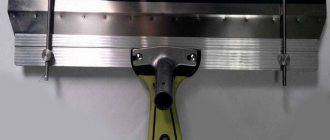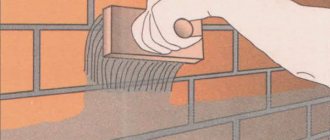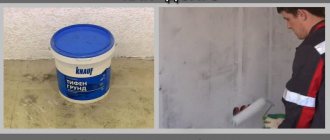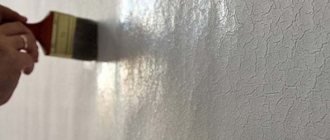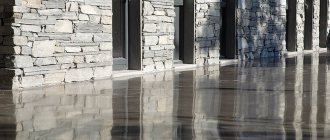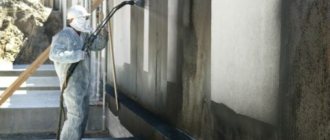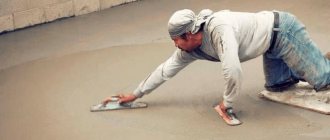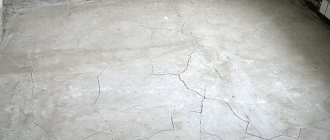Concrete surfaces, despite their initial high strength, crumble over time under the influence of regular mechanical load and moisture penetration into the pores. The only thing that can protect them from this kind of destructive factors is treatment with a special strengthening and waterproofing agent. Let's look at what impregnation for deep penetration concrete from moisture and dust is, in what cases and for what reasons it is necessary to use it, what types of it exist and how they differ, as well as what precautions are taken when working with them.
Impregnation of concrete screed with a reinforcing compound Source shlifpol.rf
Types of impregnations, their purpose and application
Impregnation is a mixture of special components, depending on the composition, sealing the surface or changing its structure. Unlike traditionally used primers, this product penetrates deeper into the material. As a result, a fairly thick hardened layer is formed, giving the surface increased resistance to the following series of destructive factors:
- Abrasion.
- Pressure.
- Mechanical loads.
- Freezing.
- Overheat.
- Temperature changes.
- Getting wet.
- Formation of microcracks.
- Corrosion (for reinforced concrete products).
After treatment, the surface layer stops producing dust and acquires water-repellent properties.
Types of impregnations according to the principle of action
Based on the principle of action on the concrete surface, deep penetration impregnations are divided into 2 types:
- Strengthening.
- Waterproofing.
Drops of water are not absorbed into the hydrophobic surface of concrete Source mpkm.org
The former make the surface layer more durable, the latter make it water-repellent. Based on the composition of their components, they are divided into 2 categories:
- Organic. They are made on the basis of polyurethane, acrylic and epoxy resin. The mechanism of action is to fill surface micropores and thereby improve the strength, water-repellent properties of concrete and resistance to aggressive environments.
- Inorganic. The product contains substances that react with the concrete mass. The components formed as a result of this interaction firmly settle on the surface and protect it from harmful factors.
Advice! Some types of impregnations change color when exposed to sunlight. For example, epoxy mixtures are best used indoors, since under the influence of ultraviolet radiation they give the concrete a yellowish tint.
Application
Impregnation of surface pores in concrete at a deep level is necessary in the following cases:
- Increased mechanical load – floors in public places, warehouses, workshops, parking lots. The reinforced layer must have sufficient thickness, otherwise it will quickly collapse.
Reinforced concrete screed Source effgroup.ru
- Dense types of concrete. The higher the density of the material, the smaller the pores. Therefore, it is necessary to use impregnation to strengthen concrete with a high penetration rate.
- Thick screed - to give more strength to the entire structure.
Note! Polyurethane-based products have the maximum impregnation ability. They bind cement dust and material, forming a single polymer layer characterized by significant resistance to impact, abrasion, wetting and aggressive substances.
Technology
The general technological process for applying impregnation to a concrete floor is the same. Any foundation requires preliminary preparation. The difference is that not all materials can work on the same surface. Plus, manufacturers provide their recommendations on working conditions.
Features of the technology for applying acrylic impregnations
General recommendations:
- concrete grade – M200, M300, M350;
- concrete moisture content – not higher than 7% by weight;
- t base and air – from +5 degrees;
- HVV - not standardized;
- curing of concrete after pouring – 3-5 days;
- the impregnation container should be kept tightly closed.
Preparation:
Removes the top loose layer, iron layer, oil, dirt. Use hard metal brushes and grinders. The main task is to completely open the pores . Dust and sludge are removed with a construction vacuum cleaner (immediately before applying acrylic impregnation).
For 1 liter of composition add 1 liter of water. The emulsion is thoroughly mixed with a construction mixer.
Application:
Acrylic impregnation is spread by rollers, with shading in mutually perpendicular directions. If required, an additional layer is arranged. Layer-by-layer slicing – 1-1.5 hours. Average consumption per layer – 0.15-0.2 l/sq.m. Ready for use after 36 hours. The instrument is washed with water.
Features of the technology for applying polyurethane impregnations
General recommendations:
- concrete moisture content – 4% by mass;
- RHV – 80%;
- t impregnation from +10 degrees;
- t air-base – 3 degrees above the dew point;
- t air, concrete - -30+25 degrees;
- concrete curing – 28 days;
- keep the container tightly closed.
Preparation:
Concrete is cleaned by sandblasting, shot blasting or using a mosaic grinder. The junctions can be worked with a hand grinder. The sludge is swept away with brushes.
Before introducing impregnation, the surface is treated with an industrial vacuum cleaner.
If the task is to obtain a filler pattern, grinding is carried out in stages : rough (3-5 mm), medium, fine (fine grain). The impregnation itself is ready for use; no preparation is required. If a decision is made to use two-component compositions, they are mixed in a 1:1 ratio and the mixture is processed with a construction mixer.
If repairs are required, they are carried out after the concrete pores have been completely closed before the final application of impregnation . After filling cracks and shells, the base is rubbed with a grinder until stains from the spatula are removed and dust is removed.
Application:
The composition is applied until the concrete is completely saturated. This is visually controlled by the formation of a uniform gloss. No puddles should form. Poorly treated areas are re-coated. Drying takes from 4 to 24 hours, depending on the temperature of the base . Consumption depends on brand strength and varies from 150 to 650 g/sq.m for 3 layers. If necessary, additional primer is applied.
Features of the technology for applying epoxy impregnations
General requirements:
- concrete strength – not lower than M200;
- humidity – 4% by mass;
- RHV – 80%;
- Concrete curing – 28 days;
- t impregnation - +15-25 degrees;
- t base, air - +5+25 degrees;
- t air-base – 3 degrees above the dew point.
Preparation:
The top loose layer is removed with a grinding machine or brushes. The pores of the concrete must be open.
Impregnation preparation:
- component B is introduced into the mixed component A without interrupting the kneading;
- operate with direct and reverse movement of the mixer;
- leave the mixture for 2-3 minutes. to release trapped air.
Application : impregnation is applied to dust-free concrete (with an industrial vacuum cleaner) without a technological break, working “crosswise”, avoiding the formation of puddles. The material is distributed in 1-2 layers. Layer-by-layer drying takes 16-24 hours. Average consumption is 220-500 g/sq.m, depending on the brand strength of the concrete. The tool is used once and cannot be cleaned.
Features of the technology for introducing strengthening lithium impregnations
The application of impregnation is determined by the processing time and the porosity of the concrete.
General recommendations:
- work is carried out on seasoned concrete (28 days), freshly laid (trodden with cut seams);
- the base must be highly durable and of high quality. Low-quality ones are processed using a different technology.
The composition should remain on the concrete for 30 minutes. There should be no dry zones, and if they exist, then add the composition there until a wet film appears
Preparation:
The work area is divided into sections. Wet concrete is dried so that all pores are free of water. The base is sanded to a degree of 80-200 grit. If the surface is dirty, it should be thoroughly cleaned after sanding.
Application:
- impregnation is applied to the surface. Maintain a flow rate appropriate to its condition (0.10-0.20 l/sq.m);
- the material is evenly distributed by a rotary scrubber dryer with brushes or pads or a large brush;
- then the remaining impregnation is hit with a scrubbing machine or a washing vacuum cleaner;
- concrete is washed with water;
- the surface becomes very slippery, caution is required when walking;
- then the base should dry completely (from 30 minutes to several hours), but it is better to leave it for 8-10 hours before continuing work;
- after impregnation, grinding and polishing to 400-1500 grit is carried out, using discs with decreasing roughness;
- the surface is inspected for imperfections.
Features of the technology for applying water-repellent impregnations
The conditions under which work can be carried out depend on the manufacturer’s recommendations. Some allow impregnation from +5 degrees, others from -20. The humidity of concrete is not higher than 60%. One way or another, concrete preparation is required. The base is cleaned of dirt and old coatings. No other manipulations are required.
Application : the impregnation is thoroughly mixed and applied to the concrete manually or by pneumatic spraying (spray guns). During operation, the gun nozzle is kept at a distance of 20-30 cm from the surface. Use a brush or roller until the surface is completely saturated. The impregnated base is not subject to additional mechanical treatment . Average consumption – 1l/5-6 sq.m. The composition is applied in 2 layers with an interval of half an hour.
Strengthening concrete
A traditional concrete floor is made using a cement-sand mortar. This means that its composition always contains salts that are susceptible to carbon dioxide corrosion. The gradual weathering of these components leads to the formation of microvoids, which then develop into microcracks, and these, in turn, into potholes and pits already visible to the eye.
Structure of penetration of impregnation into the concrete mass Source cemmix.ru
All this quickly leads to surface deformation and the constant formation of cement dust in the room. The most effective way to eliminate this primary destructive factor for concrete is to use a special deep-penetrating strengthening impregnation. This product not only binds salts, but also physically strengthens the surface layer, making it strong, wear-resistant and durable. Its effectiveness is high even for long-used floors.
See also: https://m-strana.ru/services/otdelochnye-materialy/
Reasons for accelerated destruction of wood
Trees growing in nature have reliable protection in the form of their own tree bark. During the construction of buildings or the manufacture of various wood products, the bark is removed, which entails a violation of the wood structure under the negative influence of the external environment. If structures do not have wood impregnation against moisture and rot, they will collapse due to the following factors:
- Fungi and mold - often affect wood in conditions of humidity and limited air access. Wood serves as an excellent breeding ground for harmful microorganisms, especially if it is saturated with moisture.
- Insects - the most common enemies of wood are the weevil, bark beetle, wood borer, which can not only harm the wood, but also completely destroy it. Characteristic signs of insects are small holes and grooves visible on the wooden surface.
- Moisture - rain, fog, melting snow, and simply increased humidity indoors lead to swelling of the wood and the formation of cracks, and also favor the appearance of rot. Impregnation for wood against moisture reduces the water absorption of the material without affecting its ability to “breathe”.
As additional factors that negatively affect wood, it is worth mentioning ultraviolet rays, which destroy the natural substance lignin, which is responsible for the hardness and rigidity of wood. Under the influence of the sun, wooden products become softer, lose their natural color and become cracked.
| Buy wood impregnation |
| 8 (495) 995 40 39 |
Waterproofing concrete surface
With constant contact of a concrete structure with water, destruction of the surface layer is a matter of time. Moisture saturates the pores of the material, subjecting them to destructuring. This is true during temperature changes and especially during subsequent freezing. The only way to stop the impact of destructive forces is to make the surface hydrophobic.
A concrete floor in a bathhouse requires high-quality waterproofing impregnation Source delaypol.com
A special deep penetration waterproofing compound is designed for this purpose. It is used not only to protect concrete structures that are in direct contact with water, for example, paths on a site, floors in a bathhouse, outdoor areas, etc., but also for waterproofing building structures. The use of water-repellent impregnation for concrete in such work can increase the durability, frost resistance, and thermal insulation of the entire structure.
Processing methods
One of the most common methods of protection can be considered the advance creation of a moisture-resistant concrete product or structure (primary protection).
Plasticizer is a flooring additive and paint that has proven itself in the production of high-quality ready-mix concrete and reinforced concrete products.
Basically, this method involves the following:
- correct selection of components;
- chemical impregnation of components;
- high-quality manufacturing;
- correct installation and operation.
Plasticizer and superplasticizer are the most common chemical additives for concrete used in the preparation of mixtures. They contribute to good water resistance, frost resistance and reduce moisture absorption of manufactured concrete.
Types of strengthening impregnations
Impregnations to enhance the strength of the surface layer are classified according to the main active component included in the product and are divided into the following types:
- Lithium.
The base contains lithium silicic acid. Designed for use in extreme conditions. Unlike similar products, it can be applied 2 days after pouring concrete.
Pros:
- Increased wear resistance up to 50%.
- Improved compressive strength – 30%, tensile strength – 75%.
- Resistance to water, fire, biological factors.
- Used on street structures.
The disadvantage is the high cost.
Concrete blind area next to the house, covered with lithium impregnation Source beton-house.com
- Silicate.
The main component is water-based silicic acid polymers. Pros: harmless, odorless, non-flammable. Processing is carried out in one stage. After drying, there is no need to rinse the surface - as after lithium. Suitable for interior and exterior work.
Disadvantages are uneven processing, moisture absorption and the possibility of cracks if there is silica in the concrete mass.
- Water-based acrylic.
Effective acrylic impregnation for concrete protects against dust formation and moisture penetration, promotes strengthening due to maximum deep penetration into the capillary-porous surface layer. It is used for concrete structures of grade M200 and higher - screeds, preparation for finishing coating, etc. The operating principle is based on the formation of thread-like crystalline structures that fill cracks and pores.
Pros:
- Increased strength by 2 times.
- Creation of a hydrophobic coating.
- Ease of use, no odor or harm.
- Applicable to old and new coatings.
Acrylic impregnation is safe to use indoors Source beton-house.com
How to protect a tree with improvised means?
There are many available products that can easily replace store-bought solutions. Most often used to protect wood:
- silicate (carpentry) glue;
- a solution of soda and vinegar;
- resin;
- copper sulfate;
- used machine oil;
- sulfuric acid in combination with potassium dichromate;
- compositions of boric acid, water and salt.
These options are not as effective as impregnation for wood against moisture and rot, since they prevent the effects of moisture only for a short time. If you want to get a long-lasting and really high-quality effect, the optimal solution would be to contact the TBM-Market online store and purchase reliable wood impregnations from European manufacturers.
| Buy |
Video description
Video instructions for removing dust from a concrete floor:
Pros – protection from water, aggressive substances, preventing the formation of cracks, strengthening by 3 times, dust removal.
Disadvantages - low penetrating ability and low resistance to UV radiation, which limits its applicability outdoors.
- Fluate impregnation.
This is a non-flammable impregnation for concrete floors, used both outside and indoors. Improves strength, wear resistance, removes dust, protects against aggressive substances. Penetrates to a depth of over 5 mm and is vapor permeable. The disadvantage is low efficiency on old and very fresh coatings.
Other methods
We can mention another way to save concrete from moisture - installing a drainage system. This type of protection is more suitable for street and basement spaces, where a lot of water accumulates in the area of concrete products. There are two types of drainage:
- point (drainage) drainage;
- linear drainage.
These 2 drainage systems are well suited for protecting the foundation and blind area of a building from the sudden manifestation of natural factors such as rain and running water, which destroy even durable concrete. It can be used as an addition to all other protection options.
There are also disadvantages to this method of solving the problem:
- cost;
- difficult installation;
- frequent maintenance;
- protection only from large water flows.
In general, you can use this method if there is an opportunity and urgent need to install a drainage system.
Safety Recommendations
When applying impregnating compounds to a concrete surface, it is recommended to follow safety precautions:
- Avoid penetration of liquids and pollen into the digestive tract, skin, respiratory organs and eyes.
- Use personal protective equipment - suit, gloves, goggles, respirator.
- When working indoors, ensure sufficient ventilation.
- When using flammable compounds, avoid the formation of explosive vapors, ignition sources and their mutual contact.
Advice! Regardless of where organic deep penetration impregnation for concrete is used - on the street or in the house - if it can form flammable vapors, it is necessary to take care of fire safety in advance. Primary fire extinguishing means must be within easy reach during operation.
Briefly about the main thing
To strengthen building structures, screeds, paths, concrete platforms, as well as protect them from water, aggressive substances and mechanical factors of destruction, special impregnation is used. Thanks to its special composition, the product penetrates quite deeply into the pores of the surface layer and strengthens its structure, also giving it waterproofing properties.
According to the principle of action, impregnations are divided into strengthening and waterproofing, and based on their basis - into organic and inorganic. Depending on the main component, they are divided into the following varieties:
- Lithium.
- Silicate.
- Acrylic.
- PVC.
- Epoxy.
- Polyurethane.
- Fluate impregnation.
Each type of deep penetration impregnation for strengthening concrete has its own pros, cons and application features. When applying the product, you must follow safety rules.
